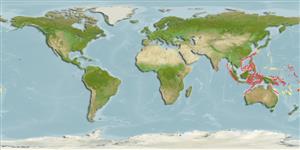Environment: milieu / climate zone / depth range / distribution range
Ecologia
marinhas batidemersal; intervalo de profundidade 200 - 270 m (Ref. 9494). Deep-water
Western Central Pacific: Philippines, Indonesia and Australia.
Tamanho / Peso / Idade
Maturity: Lm ? range ? - ? cm
Max length : 22.0 cm SL macho/indeterminado; (Ref. 311)
Espinhos dorsais (total) : 0; Raios dorsais moles (total) : 67 - 70; Espinhos anais: 0; Raios anais moles: 50 - 53. Color of preserved specimens tan to dark grey on the ocular side; tan or whitish on the blind side. Pectoral fin rays 11-13 on ocular side; 11-12 on blind side. Pelvic fin of ocular side with black spot and shorter than that on the blind side. Gill rakers elongate and pointed. 1st interhemal spine stout.
Inhabits mud and sand bottoms (Ref. 9774). Feeds on crustaceans and other benthic invertebrates (Ref. 9774).
Life cycle and mating behavior
Maturities | Reprodução | Spawnings | Egg(s) | Fecundities | Larvas
Distinct pairing (Ref. 205).
Hensley, D.A. and K. Amaoka, 1989. A redescription of Pseudorhombus megalops, with comments on Cephalopsetta ventrocellata (Osteichthyes: Pleuronectiformes: Paralichthyidae). Proc. Biol. Soc. Wash. 102(3):577-585. (Ref. 2688)
Categoria na Lista Vermelha da IUCN (Ref. 130435)
Ameaça para o homem
Harmless
Utilização humana
Ferramentas
Relatórios especiais
Descarregue XML
Fontes da internet
Estimates based on models
Preferred temperature (Ref.
123201): 11.7 - 20.8, mean 15 °C (based on 37 cells).
Phylogenetic diversity index (Ref.
82804): PD
50 = 0.5000 [Uniqueness, from 0.5 = low to 2.0 = high].
Bayesian length-weight: a=0.00741 (0.00343 - 0.01604), b=3.17 (3.00 - 3.34), in cm total length, based on LWR estimates for this Genus-body shape (Ref.
93245).
Nível Trófico (Ref.
69278): 3.5 ±0.44 se; based on food items.
Resiliência (Ref.
120179): Elevada, tempo mínimo de duplicação da população menor que 15 meses (Preliminary K or Fecundity.).
Fishing Vulnerability (Ref.
59153): Low vulnerability (17 of 100).
